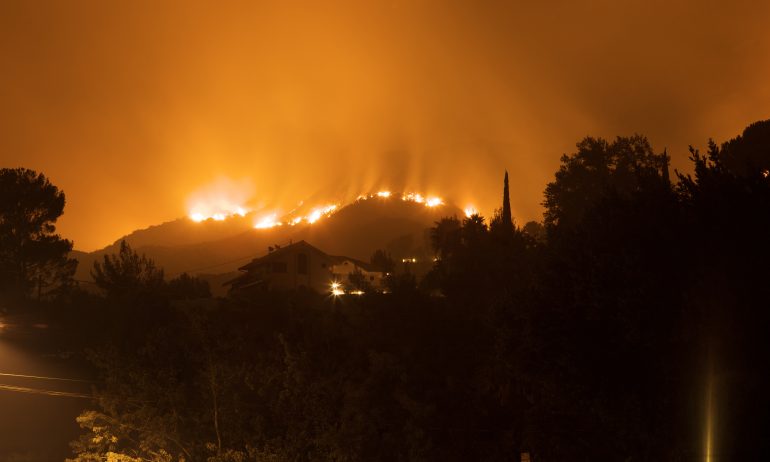Wildfire Insurance: What You Need to Know

Many or all of the products featured here are from our partners who compensate us. This influences which products we write about and where and how the product appears on a page. However, this does not influence our evaluations. Our opinions are our own. Here is a list of our partners and here's how we make money.
Table of Contents
- Does homeowners insurance cover wildfires?
- Do renters and condo insurance cover wildfires?
- What’s my wildfire risk?
- Fire prevention services from insurers
- How to get home insurance if you live in a high-risk area
- How much does wildfire insurance cost?
- How to make a wildfire claim
- How to protect yourself from wildfires
Extreme droughts and changing weather patterns mean wildfires are the new normal in many parts of the U.S., and homeowners must be ready. While you generally don’t need separate wildfire insurance if you already have a homeowners or renters policy, it’s important to understand the coverage you have.
Here’s what you should know to prepare yourself, your family and your home for wildfires.

Does homeowners insurance cover wildfires?
Most standard homeowners insurance policies cover damage from wildfires, including smoke and ash. Here’s how different parts of your policy can help after a wildfire.
Dwelling coverage
Dwelling coverage is the part of your policy that pays for damage to the structure of your home, including the roof, floors, attached decks and built-in appliances. Because a fire can destroy your home, you’ll want to make sure your dwelling coverage limit is high enough to rebuild it. Otherwise, your insurance payout could come up short.
After the 2021 Marshall Fire in Colorado, for instance, up to two-thirds of the homes that were lost may have been underinsured, according to the Colorado Division of Insurance. That means the owners likely didn’t receive enough of a payout from their insurance companies to rebuild their homes the way they were before the fire.
To keep this from happening to you, consider adding one of the following two types of coverage:
Extended replacement cost coverage. Construction costs often rise after large disasters like wildfires, so your rebuilding cost may be higher than your insurance company’s estimate. Extended replacement cost coverage can help cushion the increase by offering extra coverage beyond your dwelling limit. Say your house is insured for $300,000. Adding 25% of extended replacement cost coverage means you’ll have up to $375,000 to rebuild your house if necessary.
Guaranteed replacement cost coverage. Not all insurers offer this option, which can give you even more peace of mind. Guaranteed replacement cost coverage will pay whatever it takes to rebuild your home, regardless of your dwelling coverage limit.
Keep your insurer posted if you make any major renovations to your home, such as putting on an addition or upgrading your kitchen with high-end appliances. You may need to increase your dwelling limit to be fully covered.
Other structures coverage
If a wildfire destroys your fence or shed, other structures coverage would pay for repairs. The limit often defaults to 10% of your dwelling coverage, but you can add more coverage if necessary.
Personal property coverage
All your furniture, clothes, electronics and other belongings fall under your policy’s personal property coverage. Your limit for this type of coverage should be high enough to replace all the stuff you own.
The best way to figure out the right coverage amount — and to save yourself time if you ever need to file a claim — is to inventory your belongings. Go room by room and take photos or videos of your stuff, including what’s inside your cabinets, closets and drawers. There are several home inventory apps that can help.
It’s also important to understand how your policy covers your belongings. If you have actual cash value coverage, your insurer will pay only what your items are worth at the time they’re damaged or destroyed. So if you lose your 10-year-old sofa in a wildfire, the insurance company will pay the depreciated value of that sofa. If you’d rather receive enough to buy a brand-new sofa of similar quality, you’ll want to upgrade to replacement cost coverage.
Loss of use coverage
A homeowners policy typically includes coverage for temporary living expenses that arise while your home is being repaired or rebuilt due to wildfire damage. This coverage is known as additional living expenses or loss of use coverage. It will pay for things like hotels, restaurant bills and even pet boarding fees beyond your normal living costs.
You may be able to use this coverage if local authorities require you to evacuate for wildfires, even if your home isn't damaged.
Loss of use coverage may come with a limit, often a percentage of the policy’s total dwelling coverage. Time limits (such as 12 or 24 months) may also apply.
Do renters and condo insurance cover wildfires?
Yes, most renters and condo insurance policies cover damage from wildfires. Renters policies include personal property coverage for your belongings and loss of use coverage if you need to live elsewhere while your home is repaired.
Condo insurance typically includes both of these types of coverage and may also pay for damage to the interior of your unit, such as built-in cabinets and hardwood floors.
What’s my wildfire risk?
You can use several online tools to check your home’s wildfire risk. Start by plugging your address into FEMA’s National Risk Index map to see your risk of wildfires and other disasters such as tornadoes and earthquakes.
You can also visit RiskFactor.com, a site from the nonprofit First Street Foundation. The site predicts an individual property’s risk of fire, flooding and wind damage up to 30 years in the future.
Or check out WildfireRisk.org, a site from the U.S. Forest Service. It displays information at the community or county level and makes recommendations about what you can do to protect yourself and your home.
Fire prevention services from insurers
Several homeowners insurers partner with Wildfire Defense Systems, Chloeta and other fire prevention companies to help protect their policyholders’ homes. Their services may include:
Personalized consultations to advise you on how to make your home more resistant to fire.
Clearing brush, debris and other combustible items from around your home.
Applying a fire-retardant gel to your property.
Setting up temporary sprinklers or a portable supply of water.
These services are generally available at no extra cost to policyholders. Below are a few insurers that offer fire prevention services with their homeowners policies in select states:
How to get home insurance if you live in a high-risk area
If you live in an area prone to wildfires, you may have trouble finding an insurer willing to cover your home. A good first step is to contact a local independent insurance agent who can shop around on your behalf. They often have access to specialized insurers that are more willing to take on risky policies, often for a higher premium.
You may end up with insurance through your state’s Fair Access to Insurance Requirements plan. In most states, FAIR policies offer coverage to homeowners who aren’t able to get a policy elsewhere. FAIR plans may offer less comprehensive coverage than what you would find in the private market and may be more expensive.
In some cases, you’ll need additional insurance from a private insurer to make sure your home is fully covered. For example, the California FAIR Plan covers only fire, lightning, smoke and internal explosions. If you want coverage for things like theft or personal liability, you’ll need a separate “differences in conditions” policy.
Learn more about what to do if your home insurer drops you.
How much does wildfire insurance cost?
The cost of a homeowners, condo or renters policy will vary widely depending on where you live, the size of your home and how much coverage you need. You’ll pay more if you have a larger house or live in an area at high risk of wildfires. Your proximity to a fire station can also affect your rate. For a rough idea of what you might pay, read:
How to make a wildfire claim
If a wildfire strikes your home, file a claim with your insurer as soon as it’s safe. You may be able to do so online, by phone or via the insurance company’s mobile app.
Document the damage in photos or videos. To reimburse you, your insurer may ask you to make a list of all the belongings that were destroyed in the fire. (Note that this is an easier task if you’ve already made a home inventory.)
Don’t make any major repairs until your insurer’s claims adjuster has come out to see the damage. But do take steps to prevent further problems, such as covering a damaged roof with a tarp.
Once you start replacing your lost belongings, keep your receipts to submit to the insurance company. Depending on your policy, you may get two separate claim payouts for your belongings: one for the actual cash value of the items, and another to make up the price difference once you’ve submitted your receipts.
You’ll also want to gather receipts for expenses such as hotel stays, restaurant meals or payments for a rental apartment. All of these may be reimbursable under your loss of use coverage.
Learn more about how to file a home insurance claim.
How to protect yourself from wildfires
Here are a few tips to help you protect your home and your family from wildfires.
Create defensible space
There should be at least 100 feet of defensible space around your home to slow the spread of fires. You can create defensible space by using gravel instead of mulch for landscaping, clearing dead plants and trimming branches so trees aren’t touching each other.
Homes catch fire in a few ways: from wildfire flames, heat from vegetation burning nearby and flying embers from wildfires burning miles away. To help protect your property, try these tips from the California Department of Forestry and Fire Protection:
Cover all vent openings with metal mesh.
Remove debris from your roof and gutters.
Box in eaves with nonflammable materials.
Keep a fire extinguisher, a shovel and a hose available in case there’s a fire on your property.
Prevent wildfires
Most U.S. wildfires are caused by human activity. The Interior Department offers the following tips to reduce your risk of starting a fire:
Avoid building campfires, shooting off fireworks, burning debris or any other activities involving fire on a dry or windy day.
If you do light a campfire, choose an open location away from flammable vegetation. Make sure it’s fully extinguished and cold before you leave the location.
Never drive or park on dry grass.
Have an emergency plan
Safety should be a top priority. The American Red Cross recommends people stay informed on wildfires in the area and have an evacuation plan.
Be sure to have an emergency kit packed and ready with essentials like water, food, medication and a backup battery for your cell phone.
On a similar note...


